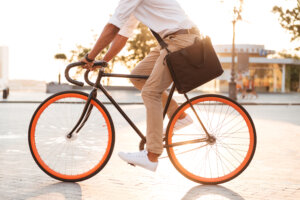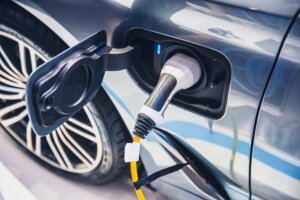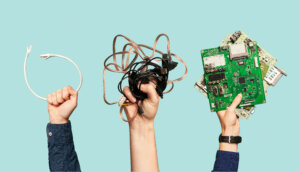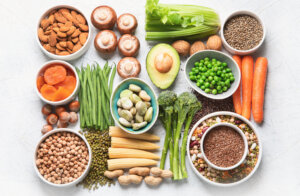By Jeremy Edwards
There are so many facets to being eco-friendly these days, it can be overwhelming to figure out which options have the greatest impact. Breaking down what we can do individually and within an organization can help us all do better in our work lives. Between commuting, recycling and eating while at work, there are so many choices we make that impact the environment. It takes action at all levels – individual, workplace and legislative – to tackle climate change. At Sunrise Banks, we encourage all employees to take steps on their own and within the company to manage their own impact on the environment.
How We Commute to Work
An easy first step is to look at how our employees are getting to work. Many Sunrise Banks employees can work remotely, which cuts out a significant amount of emissions. However, many employees still go into an office a few times a week. Our frontline employees, such as tellers and relationship bankers, are in our branches daily.
 The cleanest methods of getting around include walking, biking and taking mass transit. My daily bike ride to work takes about 30 minutes. It’s a great way to get exercise and it helps keep me happy. Minneapolis and St. Paul both have decent bike infrastructure, so I highly recommend biking if possible. If you’re not sure where your local protected bike paths are, open Google Maps and switch to the Bike Trail layer. This will show you green lines where bike infrastructure is to help you plan a commute. If you’re in Sioux Falls, there is a protected bike trail along the Big Sioux River that goes around the whole city and has a stop close to Sunrise Banks’ offices.
The cleanest methods of getting around include walking, biking and taking mass transit. My daily bike ride to work takes about 30 minutes. It’s a great way to get exercise and it helps keep me happy. Minneapolis and St. Paul both have decent bike infrastructure, so I highly recommend biking if possible. If you’re not sure where your local protected bike paths are, open Google Maps and switch to the Bike Trail layer. This will show you green lines where bike infrastructure is to help you plan a commute. If you’re in Sioux Falls, there is a protected bike trail along the Big Sioux River that goes around the whole city and has a stop close to Sunrise Banks’ offices.
If biking isn’t your style, there’s also public transit. All of Sunrise Banks’ locations in the Twin Cities and Sioux Falls Off Site Link are accessible by taking either a bus or light rail train.
 When it comes to vehicles, many people believe electric cars are the pinnacle of green transportation. While they are cleaner than gas-powered cars Off Site Link, they still have their own emissions that add up to more than biking, walking or mass transit Off Site Link. Even without a tailpipe, electric vehicles emit a type of pollution called Particulate Matter (PM) emission, specifically in two main sizes: 2.5μm and 10μm. To keep things simple, the 10μm size emissions are bad for our lungs, and the 2.5μm size emissions are bad for our lungs, heart, and brain.
When it comes to vehicles, many people believe electric cars are the pinnacle of green transportation. While they are cleaner than gas-powered cars Off Site Link, they still have their own emissions that add up to more than biking, walking or mass transit Off Site Link. Even without a tailpipe, electric vehicles emit a type of pollution called Particulate Matter (PM) emission, specifically in two main sizes: 2.5μm and 10μm. To keep things simple, the 10μm size emissions are bad for our lungs, and the 2.5μm size emissions are bad for our lungs, heart, and brain.
Because most of us still rely on driving cars, and most cities are designed around cars, walking, biking or mass transit will continue to take longer and be more difficult. If you live in an area where clean transit options aren’t feasible, you can advocate for more public transit, more electric car and bike subsidies, and denser housing ordinances. These are all effective strategies to help make commuting easier and cleaner for everyone.
How We Recycle
Recycling is another key step we can all take. Our offices have blue recycling bins all over the place for paper, cans, plastics and other materials. Our IT department also makes sure e-waste is properly recycled and doesn’t cause additional harm.
But sometimes, recycling can be confusing, causing us to second-guess ourselves. Our branches and offices rely on guidance from county recycling programs (Ramsey County in St. Paul Off Site Link, Hennepin County in Minneapolis Off Site Link, and Minnehaha County in Sioux Falls Off Site Link) to share what can and can’t be recycled.
 Our Technology Service Center (TSC) team also has a unique responsibility to manage tech resources. Many tech components contain toxic metals or rare earth minerals that must be appropriately handled and recycled. Not handling them appropriately could pose an especially negative risk to the environment. Our team works with our recycling partner to carefully to recycle damaged or unused equipment. Plus, any equipment that can still be used outside of Sunrise Banks is redeployed as a way to limit new tech purchases.
Our Technology Service Center (TSC) team also has a unique responsibility to manage tech resources. Many tech components contain toxic metals or rare earth minerals that must be appropriately handled and recycled. Not handling them appropriately could pose an especially negative risk to the environment. Our team works with our recycling partner to carefully to recycle damaged or unused equipment. Plus, any equipment that can still be used outside of Sunrise Banks is redeployed as a way to limit new tech purchases.
Reducing and reusing on an individual level can take on many different forms. One way to do this is to tell your IT department if there is any equipment you don’t need. Many employees who work remotely already have some tech they prefer using instead of company-provided equipment.
Finally, we can dispel myths about recycling that have popped up in the past few years. One of those myths is that recycled products end up at landfills. This couldn’t be further from the truth, especially for Minnesota. In fact, the law says any recyclable material placed in a recycling bin cannot be sent to a landfill or an incinerator. Companies can be fined if they break this law. Instead, the state works to ensure that our recyclable goods make it to a facility capable of handling the waste Off Site Link. According to the Star Tribune, 74% of recycled goods in Minnesota stayed in the state, and 94% stayed entirely within the Midwest. Those are numbers we can be proud of.
How We Eat
 While commuting and recycling get a lot of attention, food production accounts for a significant amount of greenhouse gas emissions. What and how we decide to eat can help bring us closer to our emissions goals.
While commuting and recycling get a lot of attention, food production accounts for a significant amount of greenhouse gas emissions. What and how we decide to eat can help bring us closer to our emissions goals.
Plant-based foods are often the most efficient food sources we can access. In fact, people who eat a 100% plant-based diet reduce their food-related emissions by 75% and their water use by 54% Off Site LinkAreas affected by drought can especially benefit from more plant-based food choices.
Choosing plant-based or vegan foods for lunch or work events is a great way to include both co-workers with dietary restrictions and those who want to make better environmental choices. And make sure you have enough on hand so everyone can taste and see how easy it is to make this change to their diet.
 Jeremy Edwards leads the Technology Services Center (TSC) at Sunrise Banks. He is also a member of the company’s Environment & Sustainability committee.
Jeremy Edwards leads the Technology Services Center (TSC) at Sunrise Banks. He is also a member of the company’s Environment & Sustainability committee.



